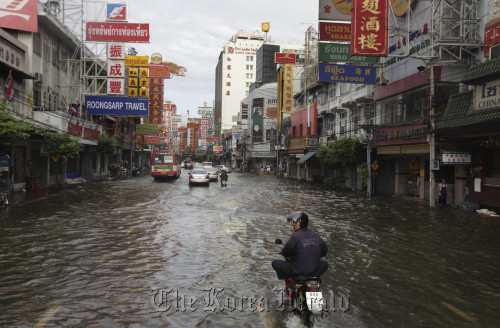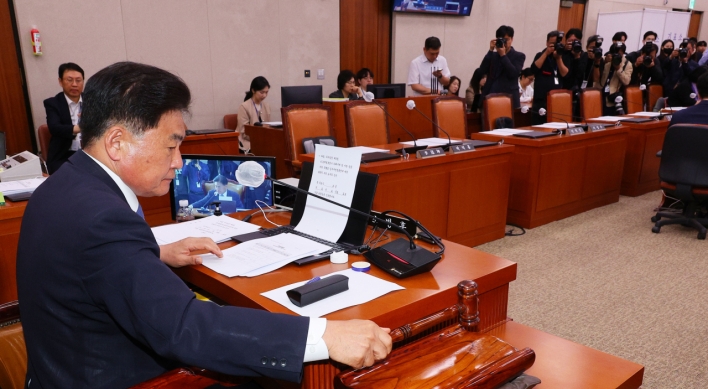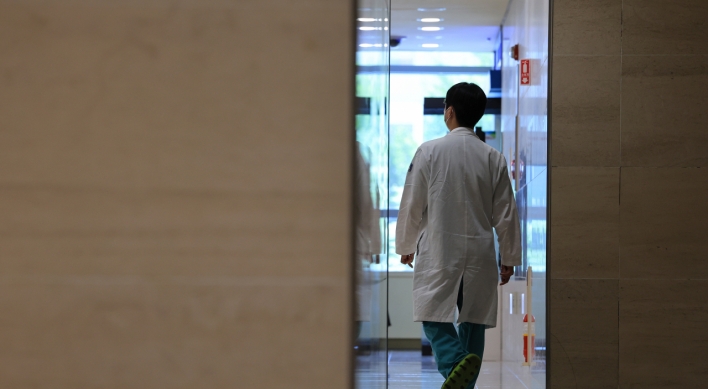Conflicting flood info frustrates Thailand’s private sector
By Korea HeraldPublished : Oct. 31, 2011 - 17:07
The private sector of Thailand has complained that it is confused by inconsistent information from the central government and the Bangkok Metropolitan Administration, saying the political conflict between the two and poor management are making the flood problem worse.
BMA officials led by Bangkok Governor Sukhumbhand Paribatra on Oct. 27 met with a number of business representatives as well as the Thai Chamber of Commerce. The meeting was meant to explain the BMA’s measures to drain flood waters from the city and listen to the private sector’s reaction to Prime Minister Yingluck Shinawatra’s warning to Bangkokians to evacuate.
Sukhumbhand said the BMA had a good drainage system, which could release flood waters at the rate of 130 million cubic meters per day or 1,600 cubic meters per second. If there is no major problem such as the collapse of flood barriers, the BMA should be able to expel the water into the Gulf of Thailand, with little impact to inner Bangkok.
However, he admitted that the BMA did not have any special measures to protect the central business district, insisting that the drainage system was sufficient to mitigate the flood impact.
He said it was difficult to predict where the floods would hit next. Although the central government has said all areas of Bangkok will be flooded, the BMA thinks differently, believing that some districts will be safe.
According to reports, the majority of the capital, including the business and shopping districts, remains dry. But a mass of runoff water continues to creep into the capital’s outskirts, with several residential areas in the north sunk by waist-deep water. The western side of the Chao Phraya has also been inundated.
Triggered by heavy monsoon rains, the nationwide flood has left at least 381 people dead around the kingdom.
Prime Minister Shinawatra now says the waters are likely to start receding soon. The end of the seasonal high tide will make it easier to drain water out to sea, she said.
BMA officials led by Bangkok Governor Sukhumbhand Paribatra on Oct. 27 met with a number of business representatives as well as the Thai Chamber of Commerce. The meeting was meant to explain the BMA’s measures to drain flood waters from the city and listen to the private sector’s reaction to Prime Minister Yingluck Shinawatra’s warning to Bangkokians to evacuate.
Sukhumbhand said the BMA had a good drainage system, which could release flood waters at the rate of 130 million cubic meters per day or 1,600 cubic meters per second. If there is no major problem such as the collapse of flood barriers, the BMA should be able to expel the water into the Gulf of Thailand, with little impact to inner Bangkok.
However, he admitted that the BMA did not have any special measures to protect the central business district, insisting that the drainage system was sufficient to mitigate the flood impact.
He said it was difficult to predict where the floods would hit next. Although the central government has said all areas of Bangkok will be flooded, the BMA thinks differently, believing that some districts will be safe.
According to reports, the majority of the capital, including the business and shopping districts, remains dry. But a mass of runoff water continues to creep into the capital’s outskirts, with several residential areas in the north sunk by waist-deep water. The western side of the Chao Phraya has also been inundated.
Triggered by heavy monsoon rains, the nationwide flood has left at least 381 people dead around the kingdom.
Prime Minister Shinawatra now says the waters are likely to start receding soon. The end of the seasonal high tide will make it easier to drain water out to sea, she said.

Sukhumbhand said the BMA could manage the floodways, canals and the drainage system within Bangkok itself, but management of the situation outside the city was the responsibility of the central government and state agencies such as the Royal Irrigation Department.
Pornsilp Patcharintanakul, vice chairman of the TCC, said that after he listened to the BMA’s position, he realized that the conflict between the central government and the metropolitan administration still existed. The information from both parties conflicts and so is untrustworthy. Thus businesses have to assess the information by themselves.
“For example, the government said the flood waters would hit all 50 districts of Bangkok, but the Bangkok governor does not think so. This different evaluation confuses people, so they don’t know whether they should evacuate or not,” he said.
He said the business sector had prepared itself to deal with the floods. Companies have constructed floodwalls.
The role of the government and the BMA is to have a concrete plan to release the flood waters after they hit inner Bangkok.
“If the government and the BMA didn’t have a political conflict, flood-water management would be done better. The longer the floods persist in Bangkok, the more loss to the country’s economy,” Pornsilp said.
The Joint Standing Committee on Commerce, Industry and Banking was to meet on Oct. 28 to discuss the relief measures.
Chai Srivikorn, president of the Ratchaprasong Square Trade Association, said the government and the BMA did not have concrete plans to drain the water. He said he did not understand why some effective floodways that are normally used to release water from Bangkok are not being used at this time, and why the government and the BMA could not evaluate the flood levels and when the water will hit inner Bangkok.
He said the government was not outlining the real situation, or offering any back-up plan, so neither the private sector nor individuals could plan in advance whether they should evacuate or what other measures to take.
Meanwhile, the 12-hour flood warning planned by the BMA seems not to be enough to allow hotel operators to get their guests to safety, Chai said.
The RSTA represents the five-star hotels and luxury shopping malls in the Ratchaprasong area such as Gaysorn Plaza and CentralWorld and the InterContinental, Grand Hyatt Erawan and Four Seasons hotels. This business area last year was seriously affected by the political violence as red-shirt protesters occupied it in April and May, paralyzing its tourism businesses. Chai said the businesses in Ratchaprasong lost about 5 billion bart last year because of the political turmoil.
Now hit by another crisis, the business members of the RSTA insist that they will not lay off workers. They have their own measures to prevent the floods hitting their buildings. At Gaysorn Plaza for example, if the flood level reaches 50 centimeters, the management team will evaluate whether to close the mall, Chai said.
Chatrchai Tuongratnaphan, executive consultant for the Thai Retailers Association, said there were still shortages of instant noodles, drinking water, canned fish, and eggs. The supplies imported from neighboring countries will enter the Thai market by the middle of next week.
He said the government should say exactly which districts of Bangkok will be submerged so that retailers can plan transport.
By Nalin Viboonchart
(The Nation)
-
Articles by Korea Herald










![[Kim Seong-kon] Democracy and the future of South Korea](http://res.heraldm.com/phpwas/restmb_idxmake.php?idx=644&simg=/content/image/2024/04/16/20240416050802_0.jpg&u=)









![[Today’s K-pop] Zico drops snippet of collaboration with Jennie](http://res.heraldm.com/phpwas/restmb_idxmake.php?idx=642&simg=/content/image/2024/04/18/20240418050702_0.jpg&u=)